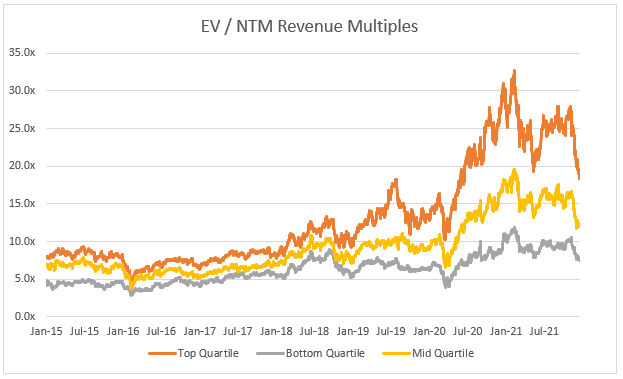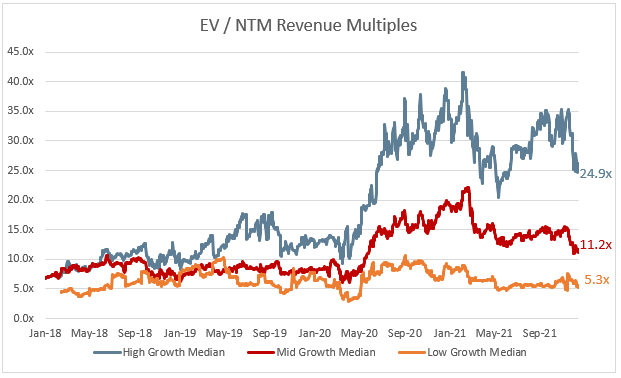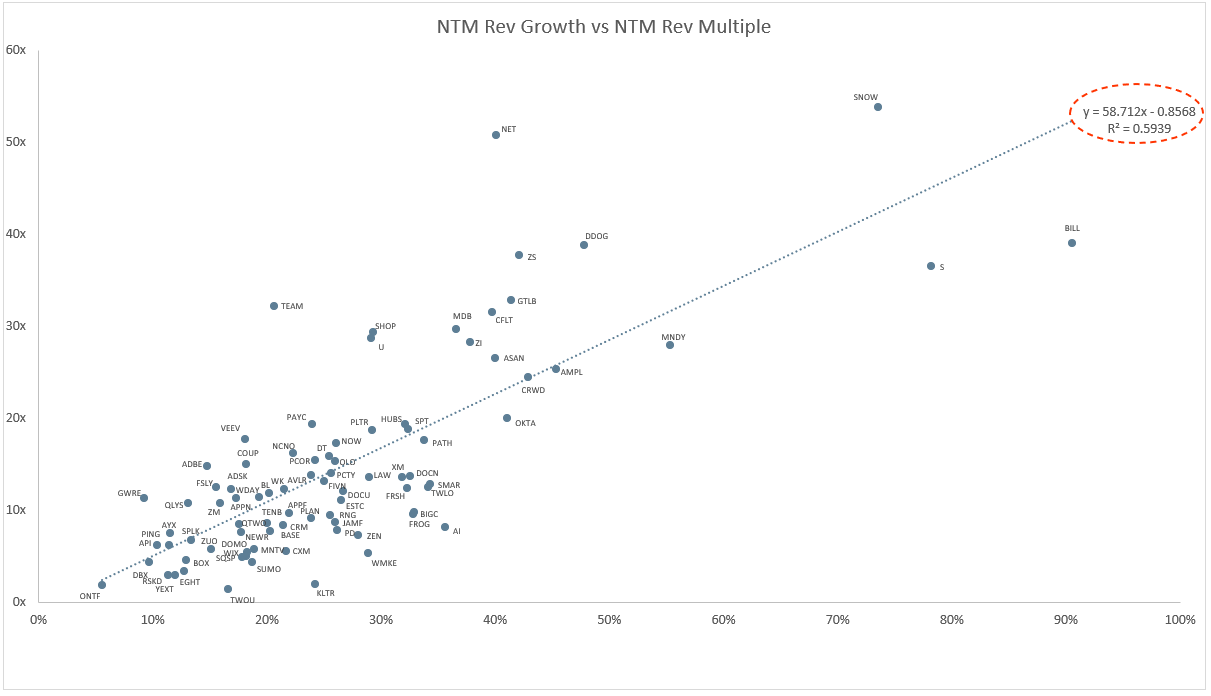Clouded Judgement 12.17.21
Every week I’ll provide updates on the latest trends in cloud software companies. Follow along to stay up to date!
Volatility!
The rockiness for cloud software stocks continues. All eyes were on the FOMC this week. More guidance around what the market should expect with regard to bond buying and rates for next year would influence how cloud software stocks (often high growth) will preform. The result? We should expect 3 rate hikes in 2022, and another 3 rate hikes in 2023. Additionally, the pace of taper will be doubled to $30B / month. Overall this was viewed as hawkish (rising interest rates to fight rising inflation). At the same time, real rates (nominal rates - inflation) rose quite a bit (nominal rates up, inflation expectations coming down). The most simplistic interpretation of this - growth asset prices should come down (rising rates = lower growth asset prices). This is precisely what we say on Thursday. Just about every cloud software company was down (some big) on Thursday. Overall on the year the median YTD
Update on Multiples
When looking at overall median cloud software multiples - we are still 12% above pre-covid highs, 35% above where we were on Jan 1, 2020, and 10% above the previous peak in August 2019. However, if you remove companies that went public during the pandemic, the overall median is right back to where we were pre-covid.
Looking at high growth software median only - we are still 76% above pre-covid highs, 108% above where we were on Jan 1, 2020, and 39% above the previous peak in September 2019.
One other way to slice the data is to look at the top and bottom quartile of multiples. Currently, the top quartile multiple is about 2.4x as big as the bottom quartile (18.4x vs 7.5x). Interestingly, this is quite similar to where we were pre-covid at 2.4x (16.3x for top quartile vs 6.9x for bottom quartile). Interestingly, the gap between top and bottom quartile remains very similar. You can see the graph of multiple by quartile below:
Top 10 EV / NTM Revenue Multiples
Top 10 Weekly Share Price Movement
Update on Multiples
SaaS businesses are valued on a multiple of their revenue - in most cases the projected revenue for the next 12 months. Multiples shown below are calculated by taking the Enterprise Value (market cap + debt - cash) / NTM revenue.
Overall Stats:
Overall Median: 12.1x
Top 5 Median: 39.0x
3 Month Trailing Average: 14.9x
1 Year Trailing Average: 15.9x
Bucketed by Growth. In the buckets below I consider high growth >30% projected NTM growth, mid growth 15%-30% and low growth <15%
High Growth Median: 24.9x
Mid Growth Median: 11.2x
Low Growth Median: 5.3x
Scatter Plot of EV / NTM Rev Multiple vs NTM Rev Growth
How correlated is growth to valuation multiple?
Growth Adjusted EV / NTM Rev
The below chart shows the EV / NTM revenue multiple divided by NTM consensus growth expectations. The goal of this graph is to show how relatively cheap / expensive each stock is relative to their growth expectations
Operating Metrics
Median NTM growth rate: 24%
Median LTM growth rate: 33%
Median Gross Margin: 74%
Median Operating Margin (19%)
Median FCF Margin: 4%
Median Net Retention: 119%
Median CAC Payback: 25 months
Median S&M % Revenue: 44%
Median R&D % Revenue: 26%
Median G&A % Revenue: 19%
Comps Output
Rule of 40 shows LTM growth rate + LTM FCF Margin. FCF calculated as Cash Flow from Operations - Capital Expenditures
GM Adjusted Payback is calculated as: (Previous Q S&M) / (Net New ARR in Q x Gross Margin) x 12 . It shows the number of months it takes for a SaaS business to payback their fully burdened CAC on a gross profit basis. Most public companies don’t report net new ARR, so I’m taking an implied ARR metric (quarterly subscription revenue x 4). Net new ARR is simply the ARR of the current quarter, minus the ARR of the previous quarter. Companies that do not disclose subscription rev have been left out of the analysis and are listed as NA.
This post and the information presented are intended for informational purposes only. The views expressed herein are the author’s alone and do not constitute an offer to sell, or a recommendation to purchase, or a solicitation of an offer to buy, any security, nor a recommendation for any investment product or service. While certain information contained herein has been obtained from sources believed to be reliable, neither the author nor any of his employers or their affiliates have independently verified this information, and its accuracy and completeness cannot be guaranteed. Accordingly, no representation or warranty, express or implied, is made as to, and no reliance should be placed on, the fairness, accuracy, timeliness or completeness of this information. The author and all employers and their affiliated persons assume no liability for this information and no obligation to update the information or analysis contained herein in the future.














NET continues to be a very bloated outlier. I have a substantial short position using put options.
"When looking at overall median cloud software multiples - we are still 12% above pre-covid highs, 35% above where we were on Jan 1, 2020, and 10% above the previous peak in August 2019. However, if you remove companies that went public during the pandemic, the overall median is right back to where we were pre-covid."
My question: what does high growth software median look like if you remove these?